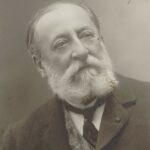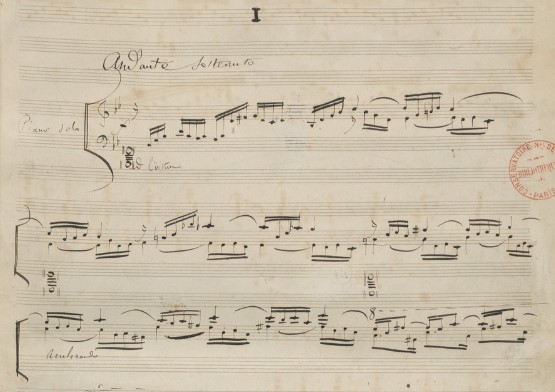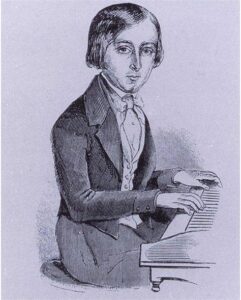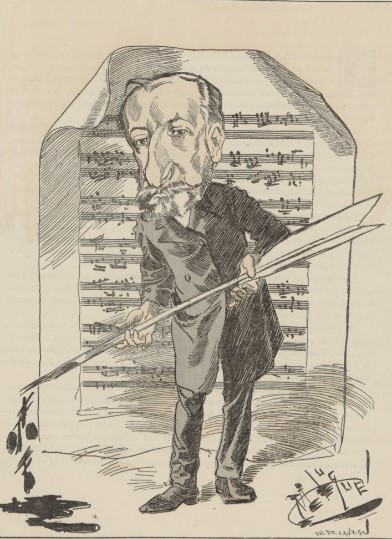 Whereas in 2020 the music world’s focus was on Beethoven’s 250th birthday, we can salute another anniversary celebrant at the start of this new year: Camille Saint-Saëns (1835–1921), although as with that of his precursor, his actual anniversary date falls only in December. ‘But just a moment now,’ you, dear blog reader, will say: ‘Beethoven and Saint-Saëns – they’re not to be compared with each other!’ No, of course not, in terms of the substance of their works and its importance for posterity, Beethoven is, so to speak, in a different league than the Frenchman. It’s certainly undeniable, though, that Saint-Saëns is still one of the most underrated of composers. So, high time to turn the spotlight on him, illuminating a bit more closely his personality as well as his work.
Whereas in 2020 the music world’s focus was on Beethoven’s 250th birthday, we can salute another anniversary celebrant at the start of this new year: Camille Saint-Saëns (1835–1921), although as with that of his precursor, his actual anniversary date falls only in December. ‘But just a moment now,’ you, dear blog reader, will say: ‘Beethoven and Saint-Saëns – they’re not to be compared with each other!’ No, of course not, in terms of the substance of their works and its importance for posterity, Beethoven is, so to speak, in a different league than the Frenchman. It’s certainly undeniable, though, that Saint-Saëns is still one of the most underrated of composers. So, high time to turn the spotlight on him, illuminating a bit more closely his personality as well as his work.
Born in Paris on 9 October 1835, Camille Saint-Saëns grew up as an only child in the care of his mother Clémence and his great-aunt Charlotte Masson, since his father, an official in the Ministry of the Interior, had died within a few months of his son’s birth. The boy’s extraordinary gifts as a polymath, encompassing music and art, together with natural sciences, mathematics and foreign languages, had already become apparent early on. He precociously learned to read, was already translating texts from Latin and Greek at age seven, as well as also solving algebra and physics assignments with just as little effort.
His great-aunt, a trained pianist, gave piano lessons to the young child who was already composing his first pieces in 1839. Everything went smoothly without coercion or drill, curiosity, talent and diligence alone producing amazing results so that he was even able to sight-read demanding scores and acquire unknown music within a brief time, thanks to his phenomenal memory. The drawback to this sheltered childhood and youth was his extensive lack of social contact with his peer group, which led to a lifelong reserve, even outright distance in dealing with friends. He was hailed as the “new Mozart” following his first public appearance as a pianist in May 1846 in the Paris Salle Pleyel, where he played, amongst other works, Mozart’s piano concerto in B-flat major, K. 450, and Beethoven’s piano concerto no. 3 in c minor, op. 37.
Just two years later he entered the famous Paris Conservatoire to work obsessively on his further training as pianist, organist and composer. A long life of numerous ups and downs followed, including a marriage that failed after only a few years. Though well-recognised in his career as an organist until 1877, he long remained controversial as a composer. When he died on 16 December 1921 in Algiers, he had composed more than 300 works in almost all genres, only about two dozen of which are currently firmly established in the concert or academic repertoire. About half of his oeuvre consists of such almost completely forgotten vocal works as choruses, cantatas and songs with piano accompaniment. Still performed of the oratorios is only the Oratorio de Noël, op. 12 (1858), of the stage works, at most occasionally Samson et Dalila (1877), although Saint-Saëns was very ambitiously convinced that just here he had done his best in his altogether 14 operas.
We are focussing from today’s perspective on his instrumental music, showing most clearly his classicism in the sense of his striving for a modernisation based on the classical composers – both such French composers as Couperin and Rameau as well as also German-Austrian composers from Bach to Beethoven. Paradoxically, his style is characteristically heterogeneous, an extremely broad palette, borrowed from music past or contemporary, domestic and foreign. It was no coincidence that he described himself as an eclectic. Composing was consequently more of a craft than a brilliant idea, more a matter of diligence than waiting for inspiration. This outlook, coupled with a noteworthy independence from popular taste, resulted in an eventful reception during his long life. Initially decried as a revolutionary in France owing to his focus on symphonic music, concertos and chamber music, enthusiasm abroad led after some time to recognition in his homeland, culminating in admiration around 1890 as one of the classical composers of French music. This changed post 1900, however, as his music was increasingly sidelined in the face of the avant-garde of a Debussy, Ravel or Stravinsky. On closer inspection, the bon mot still popular with biographers – ‘started as a revolutionary, ended as a reactionary’ – does not hold up: he was neither the one nor the other, but actively participated in the music scene, yet without any dogmatism. He was one of the cofounders of the “Société nationale de musique”, offering from 1871 a forum for new works by French composers under the motto “ars gallica”. And he was one of the first composers in France to write symphonic poems or film music, though conversely refusing the “wagnérisme” cult. His independence is also documented by his numerous articles and essays, in which he repeatedly spoke out in favour of underrated works and composers or against exaggerated fashions and admiration.

Opening of the autograph score for the 2nd piano concerto (1868, Paris, Bibliothèque nationale de France)
According to his objectified music concept – Saint-Saëns once described composing for himself as a natural process, proceeding in exactly the same way as an apple tree produces apples –, his very neatly written manuscripts show only a few corrections and rarely differ from their subsequent first editions. Thus, ideal for editors, although here too the devil is in the details, for Saint-Saëns often checked his galley proofs so cursorily that many a misprint remained.
Since the original publisher of these editions kept reprinting them unrevised, the call for new, critical editions was already growing ever louder by the end of the 20th century. As of 2016, Bärenreiter Verlag has been redressing this situation primarily for orchestral works with its complete critical edition Œuvres instrumentales complètes, edited by Michael Stegemann. Much earlier, that is, already in 2002, the Henle Verlag began preparing Urtext editions of the Saint-Saëns works. By now their number has grown to include currently no less than 21 compositions from the concerto genre (in the form of piano reductions) as well as chamber music. Aside from the third symphony, the so-called Organ Symphony in c minor, op. 78 (1886), and the symphonic poem Danse macabre, op. 40 (1874, both already appearing in the aforementioned complete edition), the main instrumental works are therefore available as Henle Urtext editions. To be mentioned first and foremost are the concertos:
• Cello concerto no. 1 in a minor, op. 33 (1872, HN 711)
• Violin concerto no. 3 in b minor, op. 61 (1880, HN 712)
• Piano concerto no. 2 in g minor, op. 22 (1868, HN 1355)
• Piano concerto no. 4 in c minor, op. 44 (1875, HN 1359)
• Piano concerto no. 5 in F major, op. 103 (1896, HN 1144)
In addition, the two concert pieces for violin
• Introduction et Rondo capriccioso, op. 28 (1863, HN 1238), and
• Havanaise, op. 83 (1887, HN 1037)
Maintaining its position unchallenged within the chamber music is the “Grand Zoological Fantasy”
• Le Carnaval des animaux (1886, HN 939, Study Edition HN 9939; already previously appearing as single editions from this cycle were Elephant HN 730 and Swan HN 943) in the top rank as probably the most popular of all his works, followed by
• Septet in E-flat major for trumpet, piano and string quartet, op. 65 (1881, HN 584),
and a series of duo sonatas:
• Cello sonata no. 1 in c minor, op. 32 (1872, HN 1057)
• Cello sonata no. 2 in F major, op. 123 (1905, HN 1280)
• Violin sonata no. 1 in d minor, op. 75 (1885, HN 572)
• Oboe sonata, op. 166 (1921, HN 964)
• Clarinet sonata, op. 167 (1921, HN 965)
• Bassoon sonata, op. 168 (1921, HN 966)
Not to be forgotten is an entire series of smaller piano-accompanied occasional pieces, in the best sense of the word, playing an important role especially in instrumental training at music conservatories and (university) music schools:
• Romance for flute, op. 37 (1871, HN 1354)
• Romances for horn (or cello), opp. 36 and 67 (1874 and 1885; HN 1167 and HN 1168)
• Allegro appassionato for cello, op. 43 (1875, HN 1227)
• Morceau de Concert for horn, op. 94 (1887, HN 1284)
• Cavatine for trombone, op. 144 (1915, HN 1119)

First-edition title page of the 1st cello-concerto score (1874; Paris, Bibliothèque nationale de France)
Having said all this, no revolutionary innovations are to be expected from Saint-Saëns’s music, though despite its stylistic borrowings and perfect craftsmanship, it is never slick or academic. From that it keeps alive Saint-Saëns’s passion for formal experiments and his pleasure in making music that can be felt everywhere, together with his fine grasp of harmonic and tonal refinement. Upon first hearing the Introduction et Rondo capriccioso you will hardly forget its rondo theme, just as is the case with the distinctive accented notes in the main theme opening the 3rd violin concerto or the exotic “Nile song” in the Andante of the 5th (“Egyptian”) piano concerto or…or…. But please discover for yourself the numerous pearls in Saint-Saëns’s music.




One of my lifelong favorites. Ogden Nash once wrote verses to accompany a Columbia Masterworks recording of “Le carnaval des animaux,” which opened thus:
“Camille Saint-Saëns
Was wracked with pains,
When people addressed him,
As Saint Sanes.”
I am exceedingly glad to see you shining some light on this great composer. Whenever I encounter his works, whether as performer or audience member, I am always astounded at how unjust history has been. I think it a fitting time to see more emphasis placed on his oeuvre. Thank you!
In Harold Bauer’s memoirs (“His Book”), can be found the following story:
Bauer was playing the first cello sonata sonata at a salon concert in Paris and Saint-Saëns, who was present, was turning pages for him. Just before the 3rd movement, Saint-Saëns asked Bauer if he could take over the piano part “because everyone always plays it too fast.” Bauer immediately switched places with him and Saint-Saëns began the movement quite slowly, but soon “his fingers took over” and by the end the tempo was “faster than anyone had ever played it” at which point Saint-Saëns turned to Bauer and said, “You see–I am a musical pig, just like everyone else!”